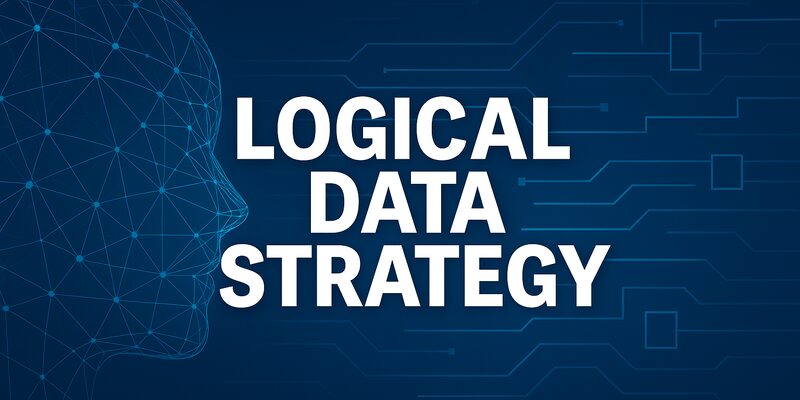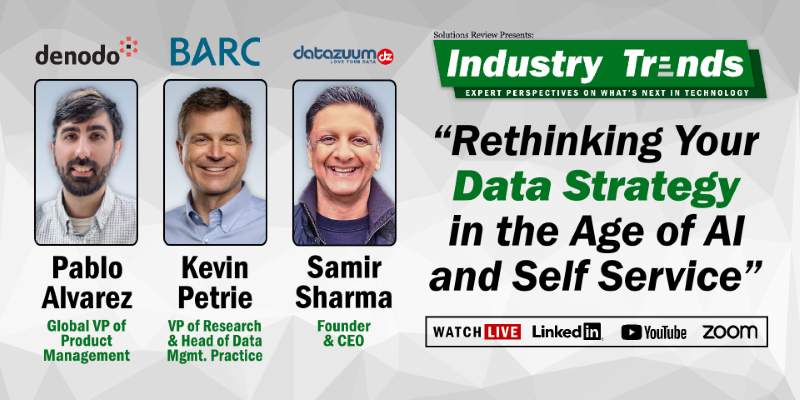The Rise of the Logical Data Strategy: On Building AI-Ready Enterprise


Solutions Review Executive Editor Tim King offers this commentary on the rise of the logical data strategy in this AI moment.
In the age of AI, the effectiveness of an organization’s data strategy no longer depends on how much data it controls, but how intelligently that data is connected, governed, and delivered. As generative AI and self-service analytics accelerate, enterprises are discovering that traditional architectures—designed for centralized control—are struggling to keep pace with the new demands for agility, context, and trust.
According to The Rise of Logical Data Management by O’Reilly author Christopher Gardner, the industry’s reliance on lakehouses and sprawling repositories has created a paradox. While these centralized models promise simplicity, they often introduce new layers of complexity and inertia. They can slow down innovation, obscure lineage, and make it harder for AI initiatives to find the high-quality, context-rich data they require.
In this emerging reality, a new concept is gaining ground: the logical data strategy. It emphasizes connectivity over consolidation, semantic consistency over duplication, and governance as an enabler—not an obstacle—of AI. This transformation is at the heart of an upcoming discussion moderated by Kevin Petrie, VP of Research at BARC, featuring Pablo Alvarez, Global VP of Product Management at Denodo, and Samir Sharma, CEO of datazuum. Together, they’re exploring what it really means to build an AI-ready enterprise.
The New Pressures on Data Strategy in the Age of AI
Artificial intelligence is both the ultimate consumer and the ultimate critic of enterprise data. Models are only as good as the data pipelines, governance frameworks, and metadata systems that feed them. The generative AI boom has intensified scrutiny on these systems, forcing leaders to ask whether their data foundations are agile enough to support scalable intelligence.
Kevin Petrie of BARC has observed that many data strategies remain trapped in analytics-first thinking—built for dashboards, not dialogue. AI doesn’t just analyze data, but it also interrogates it. And that exposes every weakness in how data is managed, cataloged, and trusted.
At the same time, line-of-business teams are demanding greater autonomy. They expect real-time access, self-service analytics, and contextualized insights without waiting in IT queues. The result is a widening gap between centralized data control and distributed business need. AI magnifies that tension: it thrives on broad data access but crumbles without coherence.
This is where a logical approach begins to show its strength. Rather than forcing all data into a single platform, it connects distributed assets through a unified semantic and governance layer. It enables agility without sacrificing oversight—an essential balance in the era of AI democratization.
Beyond the Lakehouse: The Rise of Logical Data Management
The traditional wisdom of “collect everything in one place” is giving way to a more nuanced understanding of how enterprises actually work. Data now lives everywhere—across cloud and on-premises systems, SaaS applications, and APIs. Centralizing it all is often neither practical nor necessary.
Logical data management offers an alternative. It allows organizations to manage data where it resides, applying consistent policies and semantics through abstraction technologies like data virtualization, metadata intelligence, and semantic layers.
Pablo Alvarez of Denodo explains that this approach doesn’t discard the lakehouse; it complements it. In sum, a logical data strategy doesn’t start by moving data. It starts by understanding it, governing it, and connecting it in meaningful ways.
By using virtualization and semantic unification, organizations can make distributed data act as though it’s centralized—without the costs, delays, or duplication that come from constant physical integration. This enables a single source of truth across multiple systems, providing the agility to adapt as new AI models, tools, and governance requirements emerge.
The result is not only faster time-to-insight but also a foundation that evolves in step with business change. Logical data management turns the data landscape into a dynamic ecosystem, rather than a static warehouse.
Data Products & the Business Participation Revolution
Perhaps the most profound shift of all is cultural. The age of AI demands that business and technical teams work together around shared data objectives. The concept of data products is central to this shift.
In a data-product model, business domains take ownership of specific datasets—treating them as assets that can be packaged, maintained, and reused across the enterprise. These products have clear definitions, service-level agreements, and semantic descriptions that make them easily consumable by both humans and machines.
This approach empowers line-of-business experts to shape the data they use every day, closing the historical gap between IT gatekeepers and business consumers. It also enables self-service without chaos: each product is governed, versioned, and discoverable within a federated system.
Pablo Alvarez points out that involving domain experts doesn’t mean sacrificing control—it means enhancing it. “When people closest to the data’s meaning participate in its design, the entire organization benefits,” he says. “That’s what turns governance from a burden into a source of value.”
For AI initiatives, this is critical. Data products provide the semantic richness and contextual metadata that allow models to reason more accurately. They also make it possible to ground generative outputs in authoritative, up-to-date information—an essential step in preventing hallucinations and misinformation.
Governance Reimagined: From Bottleneck to AI Enabler
For decades, data governance was viewed as a necessary evil—a series of guardrails imposed by compliance teams. Today, it has become the cornerstone of AI enablement. As organizations deploy large language models and autonomous systems, they must be able to verify data lineage, enforce access controls, and trace decision logic.
Governance is no longer about restriction. It’s about empowerment. The enterprises that will thrive with AI are those that make governance a core part of their innovation strategy.
Modern governance leverages metadata intelligence, automation, and federated policy enforcement. Instead of manual cataloging or static rules, organizations now apply dynamic controls that adapt to context.
In this model, semantic unification plays a pivotal role. By defining consistent business concepts across domains, the enterprise ensures that every model, dashboard, and query operates from the same playbook. Whether it’s sales forecasting or customer sentiment analysis, the underlying semantics stay aligned.
The unexpected rise of governance as an AI enabler marks a turning point. Where once it slowed progress, it now fuels trust—and trust is the real currency of intelligent systems.
The Semantic Layer: AI Translation Engine
The semantic layer has emerged as the connective tissue between human understanding and machine intelligence. It translates complex data relationships into business-friendly language, enabling both self-service analytics and AI integration at scale.
In practical terms, the semantic layer allows large language models (LLMs) to query enterprise data with context and precision. It anchors generative outputs in real business logic, ensuring that AI answers reflect accurate definitions rather than guesswork.
For example, when an LLM is asked, “What were last quarter’s new customer acquisitions in EMEA?”, the semantic layer ensures it applies the company’s definition of “new customer,” the correct regional filters, and the official revenue recognition rules. Without that layer, the AI’s output is just an approximation.
Denodo and others in this space have pioneered ways to make the semantic layer actionable, bridging virtualized data access with business semantics. This not only supports RAG (retrieval-augmented generation) use cases but also extends traditional BI and analytics frameworks, giving every data consumer—human or AI—a consistent, governed experience.
The result: faster innovation, fewer data silos, and far greater confidence in AI-driven decisions.
Organizational Shifts: Culture, Skills & Collaboration
No data strategy succeeds on architecture alone. The rise of AI demands new roles, new governance models, and new mindsets. Enterprises that once relied solely on centralized IT now find themselves coordinating a web of domain-specific teams, data product owners, AI governance leads, and semantic modelers.
This is where the “human layer” becomes as important as the semantic one. BARC’s research highlights that successful organizations establish data empathy—an understanding of how data serves real business goals and the people behind them.
Culturally, this means bridging the gap between technologists and business stakeholders. Skills in metadata management, prompt engineering, and semantic modeling are blending with strategic roles in data ethics, compliance, and AI stewardship.
The AI-ready enterprise isn’t just a technical construct; it’s an organizational philosophy that prioritizes collaboration, transparency, and adaptability.
Designing for Agility, Trust, and AI Readiness
Enterprises are at a crossroads. They can continue to layer AI capabilities atop brittle architectures—or they can rethink their data strategy from the ground up. The latter approach demands a mindset shift: from data hoarding to data harmonization, from control to collaboration, from static models to logical ecosystems.
An AI-ready data strategy rests on four pillars:
-
Logical connectivity: Managing data where it lives, without constant duplication.
-
Semantic unification: Ensuring every system and model shares a consistent vocabulary.
-
Governance as enablement: Embedding trust and lineage into every data interaction.
-
Business participation: Empowering domain experts to co-create and curate data products.
These principles transform data from an asset to an advantage. They allow AI systems to operate on a foundation of truth, while giving humans the confidence to make better, faster decisions.
For even more on re-thinking your data strategy in the age of AI and self-service, consult the experts via Solutions Review’s Industry Trends Session:
Note: These insights were informed through web research using advanced scraping techniques and generative AI tools. Solutions Review editors use a unique multi-prompt approach to extract targeted knowledge and optimize content for relevance and utility.



















